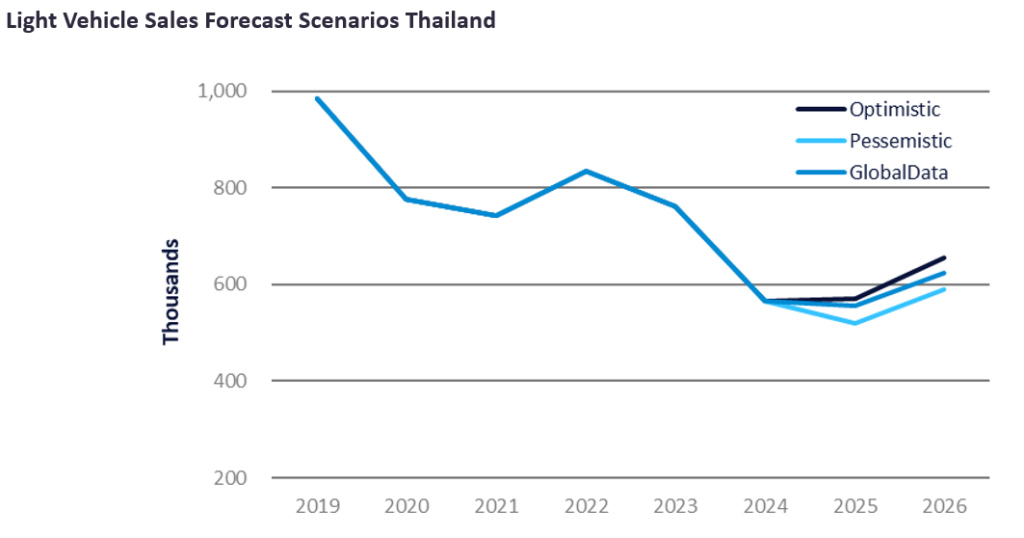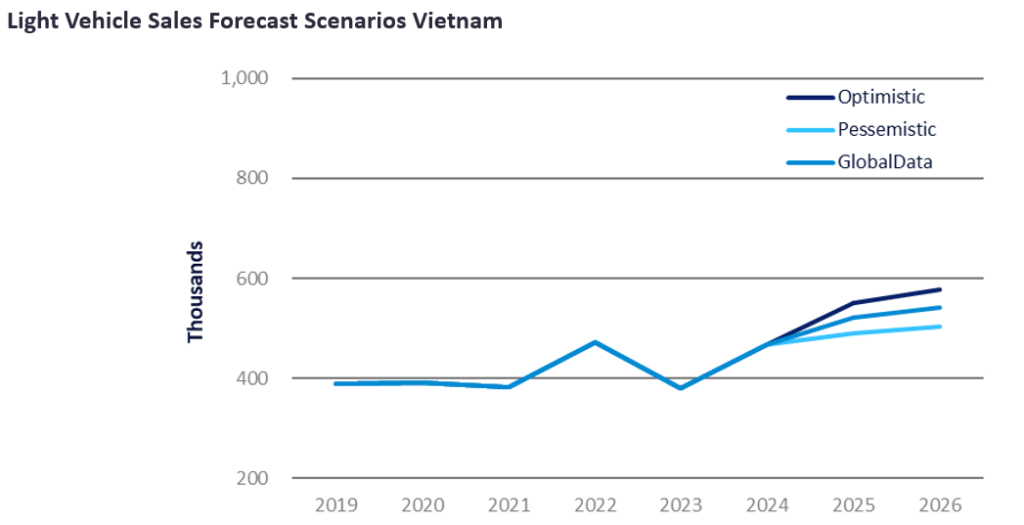Thailand’s position in the ASEAN automotive landscape is facing increasing pressure as regional dynamics shift. The country experienced a staggering 26% YoY decline in Light Vehicle (LV) sales in 2024, and the outlook for 2025 remains bleak, with a further contraction of 7% YoY experienced in Q1 compared to an already depressed base during the same period in 2024, signaling continued weakness in domestic demand.

Passenger Vehicles (PVs) and Light Commercial Vehicles (LCVs) both suffered downturns in Q1 2025, with the LCV segment particularly hard hit and dropping by a significant 13% YoY, largely due to the sluggish 1-ton Pickup Truck market. The PV segment showed a more modest decline of 5%, but still reflects broader consumer caution.
In response to these challenges, the Thai government has implemented measures to guarantee hire purchase loans for Pickup Trucks, with applications open from April 1 to December 30, 2025. This initiative aims to enhance access to financing by mitigating risks for financial loan guarantees, thereby encouraging leasing firms to approve more loans particularly for small and medium-sized enterprises (SMEs). According to the Finance Ministry, the program aims to stimulate the purchase of over 6,250 new Pickup Trucks, which could help revitalize domestic sales. Notably, the policy focuses solely on Pickups— a segment that accounted for 47% of the country’s LV sales in 2022 but 29% in 2024—with all models produced locally.
However, this target represents only a small fraction of Thailand’s annual vehicle sales, which totaled 566k units in 2024 and nearly 1 mn units in 2019, prior to the COVID-19 pandemic. As such, the limited scope of the program may not be sufficient to drive substantial change in the overall industry. Additionally, high household debt, coupled with the prevailing economic climate, may deter consumers from taking on additional loans, even with government guarantees, potentially undermining the program’s effectiveness. Although policy measures are in place, their impact has yet to materialize.
Once the leading automotive market in ASEAN, Thailand has now slipped to the third largest as of 2024, trailing behind Indonesia and Malaysia. If favorable measures are not implemented and Vietnam maintains its positive momentum, Thailand could be overtaken and fall further behind to fourth place in 2025.
Strong consumer demand, supportive government policies, and the emergence of domestic players like VinFast have propelled Vietnam’s automotive sector forward. Following a slowdown in 2023, the country’s sales have rebounded, supported by improvements in the economy, particularly in the property sector, which is recovering from the crisis that emerged in 2023. In Q1 2025, the Vietnamese market experienced remarkable growth of 53% compared to the same period last year, establishing itself as one of the region’s most dynamic markets.

US Tariffs are shifting - will you react or anticipate?
Don’t let policy changes catch you off guard. Stay proactive with real-time data and expert analysis.
By GlobalDataIn contrast, Thailand continues to face a series of economic headwinds, including high household debt, tightening credit conditions, and broader economic uncertainties. Compounding the challenge, several new vehicle launches have been delayed due to weak demand and cautious sentiment among OEMs, further limiting the market’s ability to stimulate interest and dampening its short-term sales potential.
Despite the contrasting trajectories, we remain cautious about the sales prospects for both Vietnam and Thailand for the remainder of the year. Our revised full-year 2025 forecast projects that Vietnam will achieve a record 512k units, while Thailand is expected to fall to a 15-year low of 555k units. The outlook scenarios for Thailand range from a pessimistic 519k units to a best-case of 571k units, while for Vietnam, the forecast spans from 489k units under the pessimistic scenario to 549k units in the most optimistic case. However, the projections for both markets remain subject to downside and upside risks stemming from ongoing global trade volatility, which could impact both demand and supply dynamics across the region.
Nevertheless, despite subdued domestic sales, Thailand is poised to retain its status as ASEAN’s largest automotive production hub and export base, with production expected to reach 1.39 mn units in 2025. However, it is important to note that this figure marks a decline from 1.47 mn units in 2024 and is significantly lower than the pre-pandemic production volumes of 1.99 mn units recorded in 2019.
While short-term indicators present a mixed outlook, the automotive sector in Thailand possesses several strengths. Strategic policy support, particularly for Electric and Hybrid Vehicles (xEVs), a recovery in key export markets, and ongoing investments in next-generation vehicle technologies are expected to stabilize the sector. These factors could facilitate a return to growth in the medium term and help maintain Thailand’s competitive advantage within the ASEAN automotive market.


Tanitta Tumrasvin, Manager, Southeast Asia Forecasting, GlobalData
This article was first published on GlobalData’s dedicated research platform, the Automotive Intelligence Center.





